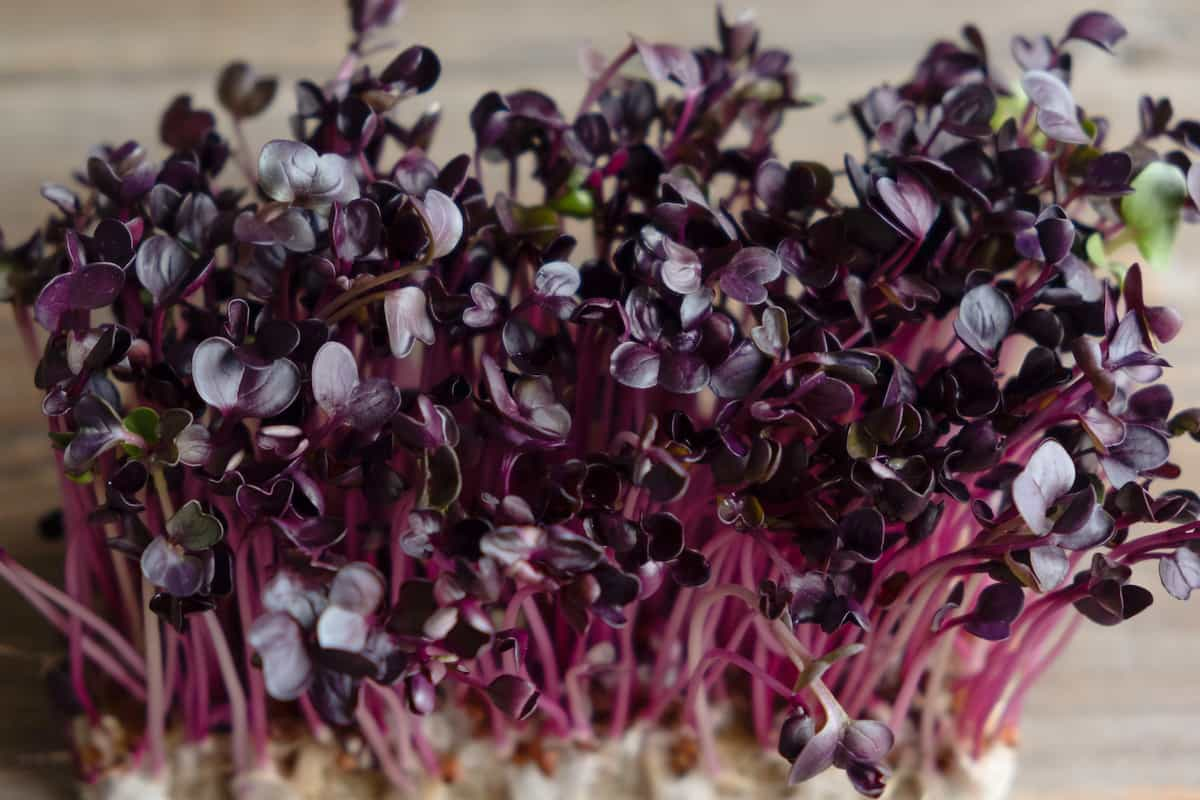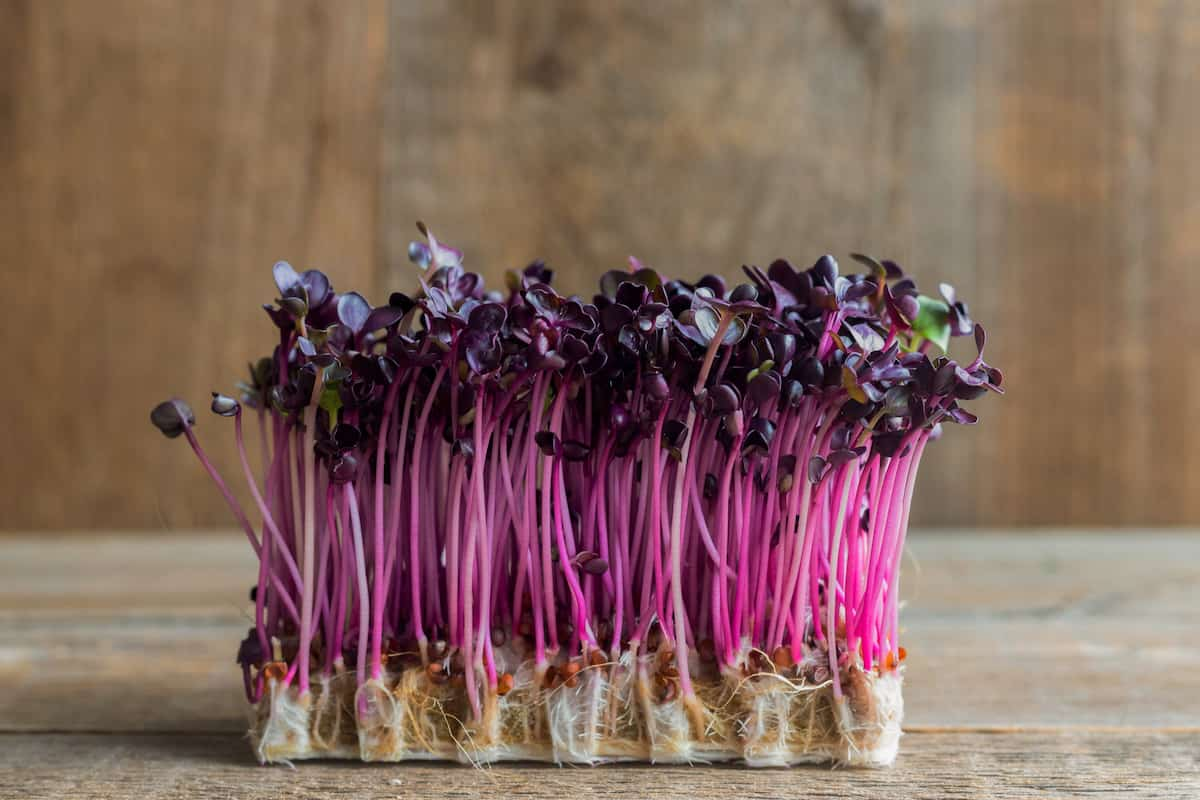The radish microgreen is a popular vegetable in Asia and Europe. These are one of the easiest microgreens to grow at home. These are baby plants of full-grown radish bulbs.

A Step-By-Step Guide for Growing Radish Microgreens
What Radish Variety Is Best for Microgreens?
You can grow any radish variety as a microgreen, but Rambo is a favorite with its deep purplish-red-colored seed leaves. There are many varieties to choose from when it comes to growing radish microgreens. They are Sango, Red Arrow, Japanese Daikon, and Triton.
Steps to Grow Radish Microgreens
- Radish microgreens are small, tender, and tasty plants that can be grown in various containers. They are easy to grow, requiring very little attention once you have planted the seeds.
- Purchase some quality seeds or start with fresh, raw seeds. You can find radish microgreen seeds at most garden centers or online.
- Prepare the planting container by mixing some organic soil with water until it is moist but not wet. Ensure the container has good drainage, so excess water doesn’t drown the plants.
- Place one or two soaked radish seeds on top of the soil mixture and gently press them down. Water your newly planted microgreens sparingly until they germinate and begin to grow roots; then, gradually increase the watering schedule as needed, keeping an eye on the soil moisture level.
- When the flowers have faded, and the leaves have grown, space your plants 2-3 inches apart and fertilize them regularly with a liquid fertilizer (water-soluble type). Feed them every two weeks during their early growth phase and then once a month after that as they reach maturity.
- Harvest your radish microgreens when they are about 4-5 inches tall and have reached their peak color; harvest often so they don’t get too big or bitter.
Can You Grow Radish Microgreens without Soil?
Microgreens are harvested so early in development that they don’t need soil or nutrient solution. This makes them ideal if you don’t have the space for bags of potting mix and prefer not to deal with the clean-ups. There are growing radish microgreens without soil methods that many gardeners are using these days.
Radish microgreens can be harvested and eaten like other vegetables, or they can be used in recipes. There are different ways to grow radish microgreens without soil, but the most popular way is planting seeds in containers and then watering and fertilizing them.
In case you missed it: Epsom Salt Benefits for Your Garden Plants: Application Methods

Some people like to start with a mixture of equal parts rye straw, vermiculite, and perlite to sow their seeds in. Once the seeds have germinated, they transplant them into 4-inch pots filled with fresh potting mix. A couple of weeks later, the plants should be big enough to plant out into 6-inch pots. At this point, you should begin watering the plants regularly and fertilize them with a low-nitrogen fertilizer every 2 weeks. The plants will grow rapidly and will produce lots of green leaves.
Do Radish Microgreens Regrow After Cutting?
No, the radish microgreen won’t regrow. This is the case with most microgreens because all their plant leaves are harvested. To get more microgreens, you’ll have to use more seeds.
The Easiest Way to Grow Radish Microgreens
- Choose the right soil: Microgreens require well-drained soil rich in organic matter. Using a mix of compost and regular garden soil is a good starting point. Be sure to add plenty of organic amendments, such as aged manure or compost tea, before planting your seeds.
- Start with fresh seeds: You’ll get the best results if you start your plants with fresh seeds.
- Choose a sunny spot: If possible, try to grow your microgreens in a sunny spot where they will receive plenty of sunlight.
- Water sparingly: Don’t overwater your plants, as this will cause them to root too deeply and stunt their growth. Make sure to water your plants regularly during germination and throughout the growing season especially if rainfall is scarce where you live—to ensure healthy growth of your microgreens.
- Fertilize regularly: Once your plants have established themselves in the ground, fertilize them once every two weeks with a balanced fertilizer designed for vegetables or fruit crops.
How Much Time Do Radish Microgreens Take to Grow?
Radish microgreens are one of the easiest to grow. They need very little preparation, and the time to harvest is less than 10 days.
In case you missed it: Getting Rid of Bad Garden Bugs: Natural Remedies that Work

Top Tips for Growing Radish Microgreens
- Choose the best variety – There are different varieties of radishes, which differ in their growth habits. Therefore, choosing a variety that will work for you is essential. It is helpful to know the types available and their growing requirements. Ensure that the variety you select fits well with the season you want for growing radishes.
- Proper lighting – These microgreens thrive well in full sunlight. However, these seeds need darkness to germinate. Ensure that your cover your grow tray for up to three days to allow all the seeds to germinate. After the radish seeds germinate, uncover the tray for adequate sunlight. If you are growing indoors, LED grow lights are a good option for providing enough light.
- Proper spacing – Ensure you have the recommended depth for planting radish seeds. Small radish needs a depth of 1 centimeter, while large radish can need up to 4 centimeters.
- Radish microgreen seeds are tiny – Ensure that you level the potting mix accurately before sowing the Radish seeds. Scatter the Radish seeds on the soil as evenly as possible to maximize the space. Use a shaker bottle to spread the Radish seeds evenly.
- Proper watering – Ensure that the growing soil is moist and not soaked. Use a mist sprayer to evenly and water the soil adequately. Once sprouts appear, start watering them from the bottom. Add a quarter-inch of water into a watering tray and then dip it in the growing tray. Let the soil absorb water from the bottom. Watering microgreens from below keep the stems and leaves dry. Dry radish sprouts reduce the possibility of damping-off disease and prevent soil from splashing onto the Radish plants.
Conclusion
Radish microgreens are a fantastic seed variety for first-time growers to sow, raise, and harvest. These microgreens contain a high concentration of vitamins and minerals.
- Feed Your Flock for Less: Top 10 Tips to Save on Chicken Feed
- Ultimate Guide to Ossabaw Island Hog: Breeding, Raising, Diet, and Care
- Hatching Answers: The Top 10 Reasons Your Chickens Aren’t Laying Eggs
- Eggs and Economics: Breaking Down the Cost of Raising Backyard Chickens
- Defend Your Greens: Proven Methods to Keep Iguanas Out of Your Garden
- Ultimate Guide to Cinnamon Queen Chicken: A Comprehensive Guide for Beginners
- Ultimate Guide to California Tan Chicken: Breeding, Raising, Diet, Egg-Production and Care
- Ultimate Guide to Marsh Daisy Chicken: Breeding, Raising, Diet, and Care
- 10 Types of Chicken Farming Businesses You Can Start for Profits